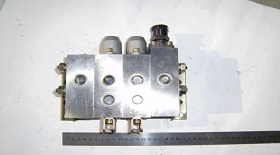The classification of hydraulic value
Classification according to structural form
The sliding valve has a clearance seal and a certain sealing length between the spool and the valve port, so there is a dead zone in the sliding valve movement.
Cone valve cone valve core half cone angle is generally 12 degrees to 20 degrees, when the valve mouth is closed for line sealing, sealing performance is good and action is sensitive.
The ball valve performance is the same as that of the cone valve.
Classification according to control mode
Fixed or on-off control valves are controlled to a fixed value of the valve class, including ordinary control valves, cartridge valves, stack valves.
Proportional control valve is controlled by the input signal proportional to the continuous change of the valve, including ordinary proportional valve and with internal feedback electro-hydraulic proportional valve.
Servo control valves are controlled with (between output and input) deviation signal proportional to the continuous change of the valve class, including mechanical and hydraulic servo valves and electro-hydraulic servo valves.
Digital control valves use digital information to directly control the opening and closing of the valve orifice to control the pressure, flow and direction of the fluid flow
Classification by use
The pressure control valve is used to control the oil pressure in the hydraulic system.
Flow control valve click flow control valve is to change the size of the valve port to change the hydraulic resistance to achieve flow control valve.
The directional control valve controls the direction of the liquid flow in the hydraulic system.
Classification according to installation connection mode
The inlet and outlet of the tubular connecting valve is connected with the oil pipe by threads or flanges.
The plate connection connects the inlet and outlet to one side of the valve body.
Cartridge valves are also divided into threaded cartridge valves and two way or cover plate cartridge valves.
Threaded cartridge valves are installed in threaded hydraulic actuators.
The two-way or cover plate cartridge valve is a multi-functional composite valve, which is composed of a core as the basic component, inserted into the valve body specially designed and manufactured, and matched with a cover plate and a pilot valve. Because each cartridge valve has two basic components and has only two oil ports, it is called the "two way Cartridge Valve".
The stack valve is based on the plate valve. Each stack valve not only acts as a single valve, but also communicates with the valve's flow path. The reversing valve is mounted at the top, and the oil outlet is opened at the bottom of the bottom plate. The other valves are bolted between the reversing valve and the bottom plate.



